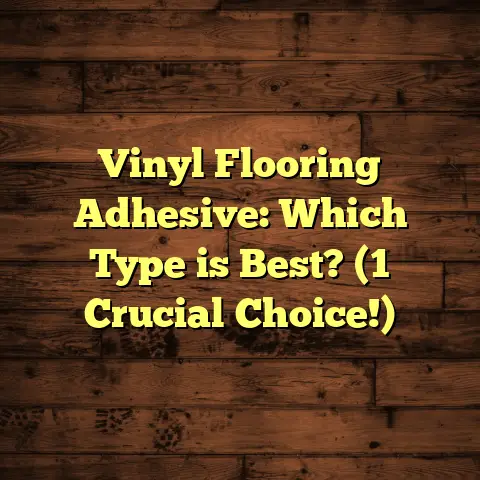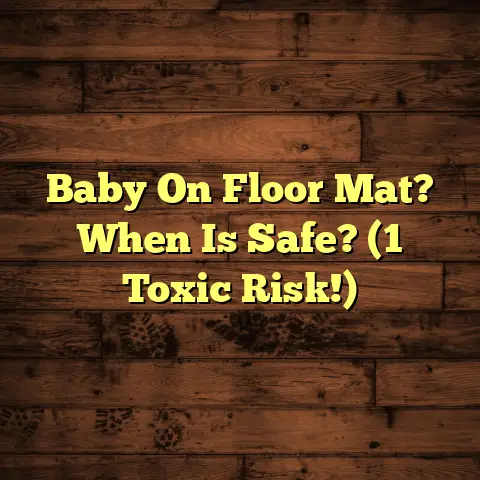Choosing Floor Finish: Expert Tips (Top 3 Fails)
Ever watched a movie and thought, “Wow, that room is stunning!”? A lot of that magic comes from the floor. Think of it like this: a well- chosen floor finish is the unsung hero of interior design. Like the perfect outfit for a movie star, it sets the stage for everything else. But just like a wardrobe malfunction can ruin a red carpet moment, a bad floor finish choice can turn your dream home into a disaster zone.
Think of “The Great Gatsby.” Those lavish parties wouldn’t have had the same impact without those gleaming, perfectly polished floors, would they? Or picture Monica’s apartment in “Friends.” The floors contributed to that cozy, inviting vibe. The right floor finish can make or break a space. Let’s dive in so you can avoid some common, costly mistakes.
Section 1: Understanding Floor Finishes
Definition and Importance of Floor Finishes
So, what exactly is a floor finish? Simply put, it’s the protective layer applied to your flooring material. Think of it as the topcoat on your nails, or the sealant on your car. It protects the floor from wear and tear, scratches, stains, and moisture.
Floor finishes come in many forms: varnishes, polyurethanes, oils, waxes, and even water-based acrylics. Each has its own unique properties, advantages, and disadvantages.
Why are they so important? Well, beyond just protection, the finish determines the look and feel of your floor. It affects the sheen (glossy, matte, satin), the color, and even the texture. A well-chosen finish can enhance the natural beauty of the wood, tile, or concrete underneath.
Think about how a character’s home in a movie often reflects their personality. A sleek, modern apartment might have a high-gloss finish, while a rustic cabin might feature a matte, oiled floor. The finish contributes to the overall story of the space.
Factors Influencing Choice
Choosing the right floor finish isn’t just about picking what looks pretty. Several factors come into play:
-
Durability: How much abuse can the finish take? High-traffic areas like hallways and kitchens need tough finishes.
-
Maintenance: How much time and effort are you willing to spend cleaning and maintaining the floor? Some finishes require more upkeep than others.
-
Appearance: What kind of look are you going for? Do you want a shiny, modern floor, or a more natural, rustic one?
-
Environmental Considerations: Are you concerned about VOCs (volatile organic compounds) and other harmful chemicals? Water-based finishes are generally more eco- friendly.
Let’s say you’re designing a restaurant. You need a finish that can withstand heavy foot traffic, spills, and constant cleaning. A high-durability polyurethane might be a good choice.
Or, imagine you’re renovating a historic home. You might want to choose a finish that complements the original character of the house, such as a traditional oil finish.
Section 2: The Top 3 Fails in Choosing Floor Finishes
Okay, let’s get to the nitty-gritty. I’ve seen countless homeowners make the same mistakes when choosing floor finishes. Here are the top three fails, and how to avoid them:
Fail #1: Ignoring the Purpose of the Space
This is a big one. People often choose a floor finish based solely on looks, without considering how the space will be used.
A kitchen, for example, is a high-traffic area prone to spills, splashes, and dropped objects. A delicate, low-durability finish simply won’t hold up. You’ll end up with scratches, stains, and a floor that looks worn out in no time.
On the other hand, a bedroom is a low-traffic area where aesthetics might be more important than durability. You could get away with a more delicate finish, like a natural oil.
I remember one client who installed a beautiful, but very soft, wax finish in their entryway. It looked stunning at first, but within a few months, it was covered in scuff marks and dirt. They were constantly cleaning and re-waxing, and they were miserable.
Think about the wear and tear your floor will endure. Ask yourself:
- Will there be heavy foot traffic?
- Will there be kids or pets?
- Will there be spills or moisture?
Choose a finish that can handle the demands of the space.
Fail #2: Overlooking Maintenance Requirements
Another common mistake is choosing a floor finish based on looks alone, without understanding the long-term maintenance involved.
Some finishes, like high-gloss polyurethanes, look amazing when they’re first installed. But they require regular cleaning and polishing to maintain their shine. If you don’t keep up with the maintenance, they can quickly look dull and scratched.
Other finishes, like natural oils, require less frequent cleaning, but they need to be re-oiled periodically to maintain their protective layer. This can be a time-consuming process.
I once worked with a client who chose a beautiful, hand-scraped hardwood floor with a matte oil finish. They loved the natural look and feel, but they didn’t realize how much work it would take to maintain. They never re-oiled the floor, and eventually, it started to dry out and crack.
Before you choose a floor finish, do your research. Ask yourself:
- How often will I need to clean the floor?
- What types of cleaners can I use?
- Will I need to re-coat or re-finish the floor periodically?
Consider your lifestyle and your willingness to invest time and effort in maintenance.
Fail #3: Ignoring Environmental Factors
Finally, many people neglect to consider the environmental conditions in their home when choosing a floor finish.
Humidity, temperature, and sunlight exposure can all affect the performance of a floor finish.
For example, in areas with high humidity, water- based finishes may take longer to dry, and they may be more prone to peeling or blistering.
In areas with intense sunlight, some finishes may fade or yellow over time.
I had a client who installed a dark-stained hardwood floor with a polyurethane finish in a sunroom. The sunlight streaming through the windows caused the finish to yellow and crack within a few years.
Consider the following:
- Is your home humid or dry?
- Does your floor receive direct sunlight?
- Are there extreme temperature fluctuations?
Choose a finish that can withstand the specific environmental conditions in your home.
Section 3: Expert Tips for Avoiding These Fails
Alright, so you know the common pitfalls. Now, let’s get to the good stuff: my expert tips for avoiding these fails and choosing the perfect floor finish for your space.
Tip 1: Assess the Space Thoroughly
Before you even start looking at finishes, take the time to thoroughly assess the space where the floor will be installed.
Consider the following:
- Traffic Level: How much foot traffic will the floor endure?
- Usage: What activities will take place in the space?
- Potential Hazards: Will the floor be exposed to spills, moisture, or other hazards?
- Aesthetic Goals: What kind of look and feel do you want to achieve?
“The biggest mistake I see homeowners make is not taking the time to properly assess their needs,” says Sarah Johnson, a flooring designer with over 20 years of experience. “They get caught up in the latest trends and forget to consider how the floor will actually be used.”
Don’t rush this step. Take your time to gather information and make informed decisions.
Tip 2: Research Maintenance Needs
Once you have a good understanding of the space, it’s time to research the maintenance needs of different floor finishes.
Here’s how:
-
Read Product Labels: Pay close attention to the manufacturer’s instructions for cleaning and maintenance.
-
Talk to Flooring Professionals: Ask your flooring contractor or retailer for advice.
-
Read Online Reviews: See what other homeowners have to say about the maintenance requirements of different finishes.
-
Consider Your Lifestyle: Be honest with yourself about how much time and effort you’re willing to invest in maintenance.
“I always tell my clients to be realistic about their lifestyles,” says Mark Thompson, a flooring installer with over 30 years of experience. “If you’re not a meticulous cleaner, don’t choose a high-maintenance finish.”
Tip 3: Consider Environmental Conditions
Finally, don’t forget to factor in the specific environmental conditions in your home when selecting a finish.
Here are some tips:
-
Humidity: In humid climates, choose finishes that are resistant to moisture damage, such as water-based polyurethanes or oil-based finishes.
-
Sunlight: In areas with intense sunlight, choose finishes that are UV-resistant, such as polyurethanes with UV inhibitors.
-
Temperature: In areas with extreme temperature fluctuations, choose finishes that are flexible and can withstand expansion and contraction.
According to the National Wood Flooring Association (NWFA), “Maintaining a consistent temperature and humidity level in your home can help to prolong the life of your wood floors and prevent damage to the finish.” You can achieve this through the use of HVAC systems and humidifiers/dehumidifiers.
Conclusion: The Ripple Effect of Choices
Choosing the right floor finish is a big decision. It affects the look, feel, and durability of your floors. It also affects the amount of time and effort you’ll need to spend on maintenance.
But the rewards of making the right choice are well worth the effort. A well-chosen floor finish can enhance the beauty of your home, protect your floors from damage, and make your life easier.
Think of it like choosing the right path in life. Like in the movie “Sliding Doors,” the choices we make have a ripple effect, influencing our future. Choosing the right floor finish is a choice that will impact your daily life for years to come.
So, take your time, do your research, and choose wisely. Your floors (and your sanity) will thank you for it.
I hope this helps you choose the perfect floor finish for your home! If you have any questions, feel free to ask. Good luck!





